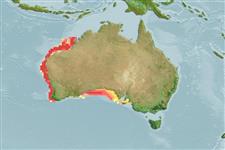Environment: milieu / climate zone / depth range / distribution range
Οικολογία
Θαλασσινό(ά) Υφαλόφιλο(α); μη μεταναστευτικό(ά); εύρος βάθους 1 - 200 m (Ref. 27560). Subtropical; 16°S - 36°S
Eastern Indian Ocean: endemic to Australian waters. Distributed from the Recherche Archipelago off Esperance, to Beagle Island, although they are rare north of Shark Bay. Records from Japan (Ref. 559, 12517) and Taiwan (Ref. 5193) are Glaucosoma buergeri (Ref. 27621).
Length at first maturity / Μέγεθος / Βάρος / Age
Maturity: Lm 30.1, range 59 - ? cm
Max length : 122 cm TL αρσενικό/απροσδιόριστο; (Ref. 27296); common length : 80.0 cm TL αρσενικό/απροσδιόριστο; (Ref. 27621); μεγ. δημοσιευμένο βάρος: 26.0 kg (Ref. 27621)
Ραχιαίες άκανθες (συνολικά) : 8; Μαλακές ραχιαίες ακτίνες (συνολικά) : 11; Εδρικές άκανθες: 3; Μαλακές εδρικές ακτίνες: 9. One dark vertical band through eye which may disappear with an increase in size; 11 dorsal fin rays and 9 anal fin rays. Supraclavicle not developed into a bony shield. Peritoneum and gill rakers pale; lateral line with 44 to 48 pored scales; juveniles with wide dark horizontal bands wider than interspaces.
Westralian jewfish live in shallow inshore waters and depths to over 200 m (Ref. 27560). They are present over hard, flat sea beds (e.g. limestone shelf) and in reefs, wrecks and underwater caverns and gutters. Adult fish move into shallower waters in the cooler months between April and June (Ref. 27560, 27561). Juveniles tend to remain in shallower water than adults and are rarely found in waters more than 100 m deep (Ref. 27560). Adults feed mainly on fish, also rock lobsters, crabs, squid, octopus and cuttlefish. Marketed as fresh fish (Ref. 10384).
Female Westralian jewfish are broadcast spawners, releasing floating eggs into the water column; these are pelagic and can be carried large distances on ocean surface currents (Ref. 6390). Larvae feed on plankton (Ref. 6390).
McKay, R.J., 1997. FAO Species Catalogue. Vol. 17. Pearl perches of the world (family Glaucosomatidae). An annotated and illustrated catalogue of the pearl peches known to date. FAO Fish. Synop. 125(17):26p. Rome: FAO. (Ref. 27621)
IUCN Red List Status (Ref. 130435)
Threat to humans
Harmless
Human uses
αλιεία: Εμπορικό(ά); αλιεία αναψυχής: ναί
Εργαλεία
Special reports
Download XML
Διαδικτυακές πηγές
Estimates based on models
Preferred temperature (Ref.
123201): 15.9 - 26.7, mean 20.4 °C (based on 86 cells).
Phylogenetic diversity index (Ref.
82804): PD
50 = 0.6250 [Uniqueness, from 0.5 = low to 2.0 = high].
Bayesian length-weight: a=0.01622 (0.00767 - 0.03431), b=2.94 (2.74 - 3.14), in cm total length, based on LWR estimates for this (Sub)family-body shape (Ref.
93245).
Τροφικό Επίπεδο (Ref.
69278): 4.3 ±0.62 se; based on food items.
Ελαστικότητα (Ref.
120179): Μεσαίο(α), ελάχιστος χρόνος για διπλασιασμό πληθυσμού 1,4 - 4,4 έτη (tm=3-4; Fec=300,000).
Fishing Vulnerability (Ref.
59153): High to very high vulnerability (72 of 100).
Nutrients (Ref.
124155): Calcium = 13.1 [7.2, 22.1] mg/100g; Iron = 0.462 [0.271, 0.742] mg/100g; Protein = 20 [19, 21] %; Omega3 = 0.209 [0.128, 0.335] g/100g; Selenium = 24.5 [12.8, 44.0] μg/100g; VitaminA = 50.5 [18.2, 135.2] μg/100g; Zinc = 0.478 [0.332, 0.687] mg/100g (wet weight);
